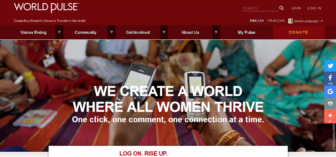
The Sisterhood of Investigative Journalists: Rana Sabbagh, Prangtip Daorueng, Stella Paul and Esther Htusan at the Minorities and the Disenfranchised session.
When reporting on minorities and the disenfranchised, it’s critical to understand the historical-cultural context and sensitivities, a panel of veteran investigative journalists told participants at the Uncovering Asia 2016 conference in Nepal.
Prangtip Daorueng from Thailand, Stella Paul from India, and Esther Htusan from Myanmar have all covered disenfranchised communities in their countries. Below are their tips on smart reporting, from story conceptualization to dealing with the aftermath.
Finding the Story
Covering minorities is about the people, not power, Daorueng underscored.
“Journalists like to check on politicians and tycoons. When you want to do a story about the minorities, start with the ordinary people who suffer,” she said.
Research
Do your research before you head into a minority community by talking with experts and reading academic analyses. The historical, religious or cultural context can be very complicated and there may be animosity between minority groups, noted Htusan.
Sources
Find out who you can talk to in the community and make sure they are credible. Private institutions and lower-level government officials can be good sources.
“Do not wait until you reach the place to ask questions. One great source of information is usually the driver who is bringing you there,” Paul said.
Daorueng and Paul both noted that journalists should never pay for stories because of the risk that impoverished sources may dilute or embellish a story to give you what they think you want.
Approach
Take care to not cause political, physical or emotional harm to minority communities or individuals, and be extra sensitive about publishing photos and names.
Daorueng told a story of an ethnic Karen girl, who was rescued 3 years ago after being kidnapped by a Thai couple when she was 7 years old. The media were shown the girl’s injured body as a social worker stripped the 12-year-old half naked and pointed at her scars.
“I asked her about the time when she was rescued, she said she disliked being naked in front of others,” Daorueng shared, emphasizing that victims should be treated with more empathy.
In addition to empathy, honesty and building an instant bond is important, Paul noted. “A great way to bond is through ‘food diplomacy.’ If you eat their food together with them, they will immediately accept you,” she said.
For the Pulitzer Prize-winning Seafood From Slaves story, which exposed the practice of slavery in Southeast Asia’s fishing industry, Htusan said they interviewed around 100 people a day.
“Try to get all the interviews you can, then you can find a [great] character and that makes the story stronger,” Htusan said.
Devices
Go as device-less as possible, but if you must, keep the gadgets small, non-bulky and invisible. If security forces approach you and you are about to be questioned, take out your SD card and hide it immediately, Paul said.
Safety
It’s good practice to “leave bread crumbs” of your journey with the people you speak to. Share your information with the first person you are communicating with, the second, third, and so on, because these are the people who will help to find you if anything untoward happens.
Fact Check
Vulnerable minorities and experts alike may manipulate their stories, so it’s important to cross-check with non-governmental organizations working on that subject, Htusan suggested.
Make use of readily-available documents: company records, annual reports, stock market records, official investigations, police records, and academic research. However, do not take information at face value, even if it originates from a reputable organization or think tank. “Don’t trust data from open sources, collect data yourself. You have to go to the field,” Paul said.
Frame the Big Picture
“We do not report one tragedy after another—each individual case will form a pattern to help explain the big picture. There must be something wrong with the system somewhere or [if] not, why are these things happening?” Daorueng said.
Trauma
 When things get tough, Paul, who had previously been kidnapped on the job, said she reaches out to the global sisterhood World Pulse, a social network of women helping each other.
When things get tough, Paul, who had previously been kidnapped on the job, said she reaches out to the global sisterhood World Pulse, a social network of women helping each other.
Depression is a stark reality for journalists in Myanmar as they are under pressure from so many factions, Htusan shared.
“Sometimes I don’t feel like wanting to be a journalist anymore, but when I think back on those communities [I covered], I am way luckier than these people. You have to just keep working on the stories,” Htusan said.
 Eunice Au is GIJN’s program assistant. She was previously a journalist in Malaysia for eight years and has written on a range of topics, including politics, crime, environment, terrorism, and entertainment. From 2011 to 2015, she worked for the New Straits Times. Her last position before joining GIJN was as Malaysia correspondent for Singapore’s The Straits Times.
Eunice Au is GIJN’s program assistant. She was previously a journalist in Malaysia for eight years and has written on a range of topics, including politics, crime, environment, terrorism, and entertainment. From 2011 to 2015, she worked for the New Straits Times. Her last position before joining GIJN was as Malaysia correspondent for Singapore’s The Straits Times.
